
Deposition Date
2015-06-19
Release Date
2016-01-27
Last Version Date
2024-03-06
Entry Detail
PDB ID:
5C53
Keywords:
Title:
Probing the Structural and Molecular Basis of Nucleotide Selectivity by Human Mitochondrial DNA Polymerase gamma
Biological Source:
Source Organism:
Homo sapiens (Taxon ID: 9606)
DNA launch vector pDE-GFP2 (Taxon ID: 415098)
DNA launch vector pDE-GFP2 (Taxon ID: 415098)
Host Organism:
Method Details:
Experimental Method:
Resolution:
3.57 Å
R-Value Free:
0.33
R-Value Work:
0.29
R-Value Observed:
0.30
Space Group:
P 41 21 2


